~ Meine Doodle ~
The Strange Case of Camouflage on German Film
Part I
When looking through the the photographic record of the German (et al.)
invasion of the Soviet Union, one encounters many images which seem...
well... slightly standing out. Some of these images portray captured VVS
aircraft wearing the most extraordinary camouflage schemes-- stripes, blobs,
patternations, multiple colours, and the lot. Almost as if the Soviet aviation
regiments had nothing else to do during the early Barbarossa period
than to invint new forms of camouflage in the field for their aircaft.
Now, read that again-- "...nothing else to do during the early Barbarossa
period ".... What?! Surely, that makes no sense whatever. During a
period of maximum stress, retreat, and military disasters, we are to assume
that the VVS took an inordinate amount of time to engage in elaborate camouflage?
When the average regiment was struggling mightily to get fuel, lubricants
and parts to keep their machines in the air, they simultaneously wasted
hours and hours on tactical decoration? Something, here, seems very much
amiss with this picture.
The Period Image
Looking for a possible explanation to this conundrum, one should take
note of a number of related facts which certainly may bear on the answer.
It is the case that the Nazis made extensive use of visual imagery to support
their propaganda and world view. Germany (and indeed the rest of Europe)
was inundated with Nazi art, Nazi film, Nazi symbols and iconography, Nazi
cultural events, Nazi meetings and marches... the list is endless. The
power of visual images was forefront in the arsenal of political weapons
to the Hitlerite regime, and those living in Germany would have been exposed
not only to the influences of these images, but also to the mechanism of
visual expression, as well.
I have always been struck by the enormous number of photographs residing
in the personal collections of German ex-soldiers. Quite literally, many
thousands upon thousands. The Bundesarkiv contains some 10 million
images (all types of media), of which it is estimated that 5% relate to
the Second World War. That amounts to 500,000 photographs-- an astounding
number of images! And this is to say nothing at all of the huge collections
of photos in private hands. I mention these astronomical totals as an example
of the clear enthusiasm that must have existed in Germany ca 1930-45 for
photography. One wonders if-- or indeed, suspects-- the aforementioned
behaviour of the Nazis had some kind of stimulating effect on this matter,
effusing the average German of the period with both and interest in, and
an acute appreciation of, photography and images?
Whatever the underlying cause, there is no escaping the fact that German
soldiers took very large numbers of pictures. Of these, a very large portion
taken during the early War years (1941-42) depict what one might call 'trophies'.
That is to say, many of the photographs taken by German soldiers on the
Russian front at this time show various forms of wrecked enemy equipment--
tanks, emplacements, guns, and of course aircraft. This fact by itself
is not difficult to understand. However, the appearance of the enemy equipment
that they show is curious in a number of ways. In this article, naturally,
we will consider the appearance of enemy aircraft, but it should be born
in mind that these are not the only objects to demonstrate such painting
oddities.
Patterns of Patterns
When looking over the German photographic record of enemy (Soviet) aircraft,
one is struck at once by a very large number of examples which sport unusual
and fascinating camouflage. Many of these seem, at least to an eye experienced
in observing VVS practices, rather.. well... out of place. Or, perhaps
"unlikely" is a better word. Most of the curious examples which appear
on these German photos show camouflage which is never seen on pictures
of VVS aircraft taken by Soviet photographers, even of the same types from
the same period of time. Moreover, the forms of some of the camouflage
applications seem to be in contradiction to what we might call the 'typical'
VVS type work regarding field applied maskirovka. Very curious observations,
these.
After some prolonged thought on the matter, it occurred to me that indeed
there were some features which all of these images appear to have in common.
Despite the varied appearance of these examples, it always seems to have
been that case that:
-
The aircraft was never in operational condition; i.e. always a wreck, derelict
or abandoned, etc
-
The camouflage pattern in view was similar to examples found on images
of period German aircraft appearing on German film
-
The aircraft was not located at an airfield or other German base, but out
in the open somewhere (possibly with one exception)
These are pretty specific conditions to apply to such a broad range of
subjects. In fact, I find them to be somewhat suspiciously specific. Why,
for example, if the appearances of these aircraft were truly random, would
we never-- not even once-- see these extraordinary camouflage schemes on
a VVS wreck at an airfield? Or, on an aircraft in mechanical order? Or,
indeed, on a picture taken by a Russian source? There is something decidedly
not random about all of this, it seems to me.
In contemplating these matters, I have come to develop a rather startling
theory [well, it certainly was for myself]. I believe that the best
explanation for many of these images is that the curious camouflage applications
in view were in fact applied by Germans, in cases possibly the
same who took the photograph. Well, this begs the immediate question of
why on earth German soldiers would sit around painting things? Alas, this
question I cannot answer. Certainly such deliberations are well outside
the scope of this article, and such behaviour and the complex motivations
underlying it would be the legitimate subject of several academic papers
on the matter. I will only note here that German soldiers took photographs
of things which soldiers from other countries never seemed to do, and in
record numbers. All of this smacks to me of this kind of orientation towards
imagery and expression through pictures which is mentioned above.
Right, there is the theory, but let us take a look at some actual examples.
In the following, one should take note of the various similarities and
differences in view. Are there patterns to be found here? What are the
most likely explanations? Some of these cases are truly mysterious....
The Spotty SB
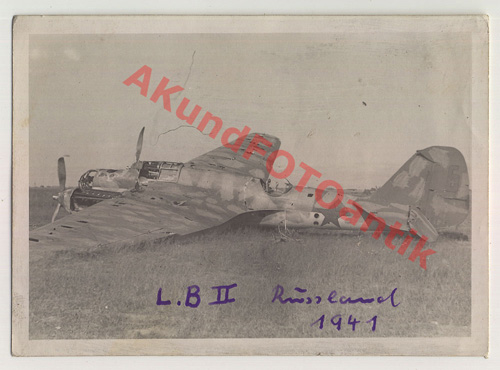
Here we have an SB photographed, as always, in exactly the conditions
described above-- a wreck in a field, abandoned, obviously having sat for
some time (note the grass), and showing a German-looking scheme. The aircraft
seems to have had an original AII Green application, this then supplimented
with 'blobs' of colour. The colour of these blobs is impossible to say,
especially noting that we have here an unidentified type of German (presumably)
film stock.
The appearance does not match that of any known Soviet photograph on
any SB in VVS service. But, it does match extremely well many types of
Luftwaffe camouflage. Indeed, quite topically it resembles the African
Bf 109Es that featured on the cover of an issue of Signal magazine
(a German propaganda magazine focusing on the Luftwaffe) at just this time.
Is this observation a mere cooincidence? It's an intriguing question.
Wavy SBs
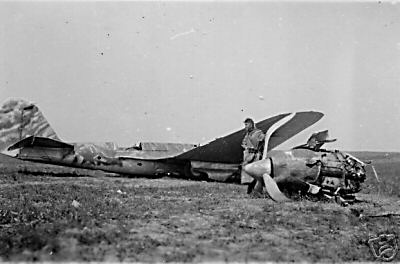
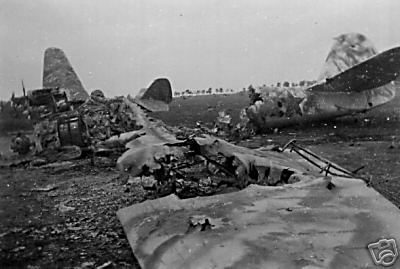
These derelict SBs demonstrate a rather similar appearance in many
ways. The somewhat 'tiger-stripe' pattern here is unique, especially on
the aft/left example. These two aircraft might be an exception to the usual
rule in that they could possibly be sitting at an airbase (or forward airstrip),
and it is impossible to say how long they had been there when photographed.
However, in all other respects these examples fit the general pattern of
such aircraft.
The camouflage applique is rather complex, to be sure. Once again, it
does not resemble VVS practices with regards to the usual field applied
camouflage. It does, however, resemble very much the camouflage applied
to Bf 109s in Russia at this time, for example that of Lt. Beisswenger
of JG 54, or that of Lt. Steindl of the same unit. Moreover, the appearance
of the paint itself is exceedingly suspicious. The area around the
engine nacelle was obviously heavily burnt out. The temperatures here were
high enough to cause the dural skinning to sag and droop downwards into
the cavity, as is clear in the image. And yet, these same areas are painted!!
What sort of paint is this that were are supposed to believe can withstand
such high temperatures, and open flame?! This seems quite utterly impossible,
and yet this is exactly what we see in both cases here. Note also that
the scheme on the tail of the right/fore example does not really quite
match that seen on its wing or around the national star, and has a more
typical VVS look about it.
The Real Oddity
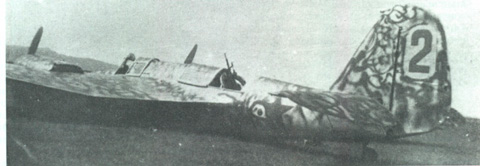
Here is an interesting example of field applied camouflage which is
an authentic VVS scheme. This image was taken by Soviet photographers of
SB "Red 2" of the 49 SBAP during the summer of 1940. The camouflage here
is probably AEh-15 Green applique over AII Aluminium base, and such patterns
were quite common on VVS aircraft in Manchuria, for example, as well as
in the Western Districts. The pattern over the tail is notable for its
similarity to the tail section of the example above and right, whilst simultaneously
being incongruous with the pattern over the remainder of these curious
SBs.
U-2, Too?
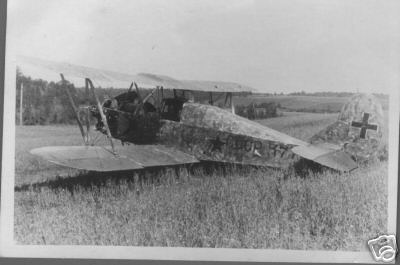
This Polikarpov U-2S is another example of such work which fits the
general pattern which we have outlined already. The wings and horizontal
stabilizer of this example demonstrate no unusual colouration, whilst the
fuselage has been modified by extensive dapple applique, which has also
partly obliterated the civil code here. The significance of this observation
should be highlighted-- that is to say that the areas which would be more
difficult for any would-be 'artist' to access have been left as-were, while
the large ready-made painting canvas of the fuselage was heavily reworked.
The rudder even sports some kind of make-shift Luftwaffe type marking,
though why would one see a cross here and not a swastika? Is this
evidence of a lack of understanding of Luftwaffe practices, as one might
expect with a German infantry soldier (for example)? If this is an original
Red Cross marking (via Sanitary Aviation), then why the Soviet national
star on the fuselage, and more importantly, why the camouflage at all?
Strange Peshkas
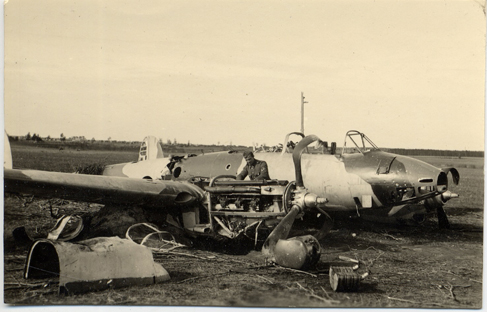
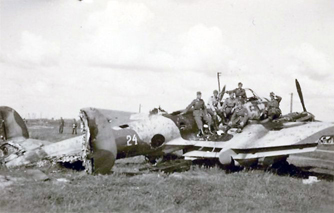
Here are two Pe-2s wearing rather unusual camouflage as photographed
by German troops. The similarity in the two schemes is quite striking,
and one would not be surprised to find that they were part of the same
unit, or indeed even that the same person had painted both aircraft. Both
examples show 3-colour patterns, and it would seem (bearing in mind we
have German film here) that each have employed the same paints.
What strikes me the most with these examples, however, is that the patterns
seen on the camouflage are quite 'VVS-looking' to my eye. That is to say
that the form and placement of the demarcations of colours are similar
to what one sees on other Soviet aircraft, even down to the typical wingroot
'blob' areas of colour and the angled nose features. Furthermore, splinter
damage appears in the left example to be located over the paint, disrupting
it in the expected way should it have occurred after the painting. To the
right, burn and other damage to the paint work is observable in several
locations.
With these observations in mind, it is my theory that these two Pe-2s
are authentic examples of field applied VVS camouflage of the early Barbarossa
period. Early 3-colour camouflage is known on other Soviet bombers (the
DB-3 and Er-2, often), and on balance I would suggest that here we have
two more examples of this kind of work.
The Il-2 Object d' Art
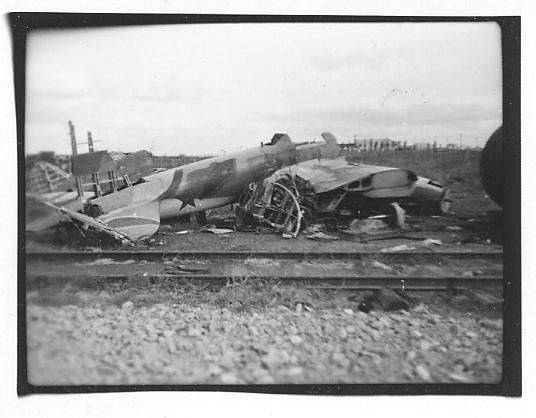
This highly derelict Il-2 was photographed in 1942 by German personnel.
It shows the remains of an Il-2 single-seat aircraft, and alas the wing
outer sections seem to be missing. The camouflage in view is again highly
unusual, and seems to consist of at least four different colours, a procedure
not known on any serving VVS aircraft. The colour areas on the fuselage
are quite notable in that these seem to terminate at precisely the height
where an average man standing on the ground next to the wreck could reasonably
reach with a brush. Their patternation is quite un-VVS like in appearance,
even beyond this odd termination.
The outline pattern on the stabilizer is fascinating. There does exist
one such authentic VVS example somewhat like this (on a Yak-7), but there
are by far many more such examples of German aircraft from this period.
Several Bf 109s in 13./ JG 52 in the Kuban during 1942, for example, were
finished precisely like this, with the same tonal appearance and execution
of line and outline. Furthermore, if this were the original VVS field scheme,
why does it not appear over the entire airframe, but rather only on one
easily accessible bit of it?
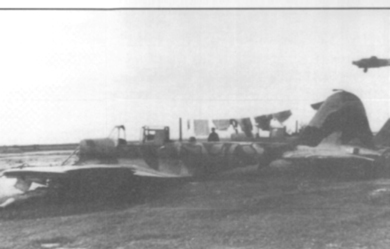
This example is extremely similar. Once again we see odd outlining
on the vertical stabilizer, and Luftwaffe like segment patternation on
the fuselage. No such similar scheme is seen any on any known serving VVS
aircraft. One can also appreciate that this example has been in proximity
to German troops for some time, its aerial mast serving as a pole to support
the laundry line.
A Mud Scheme?
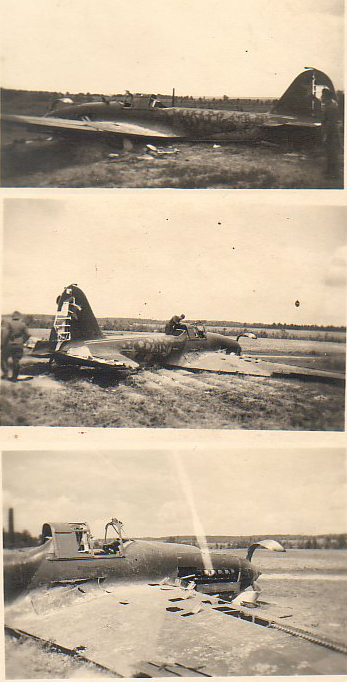
This series of photographs depicts a crashed Il-2 single-seater sometime
during 1941. In addition to the extremely fascinating detail data which
these pictures reveal of this quite early example, we see here yet more
strange camouflage applique. The base camouflage scheme seems to be a known
pattern application from Factory 18. Over this there is considerable applique
in the form of Luftwaffe style segmented 'blobs', but in this case over
the rear fuselage only. To apply such field design only to limited parts
of the aircraft was not a VVS practice; it was, however, seen on German
aircraft.
More curious than this, though, is the nature of this camouflage applique.
One may see the considerable tracks of dried mud left on the starboard
wing from various footprints, etc. It is remarkable to note how very much
this colour, seen also on the ground below the aircraft, matches the tonal
properties of the camouflage applique. Since the conditions must have been
dry (as evidenced by the remaining dirt on the wing), is it then also possible
that the 'artist' applied this camouflage pattern using mud, and
that the pattern we see here is not paint at all, but dried soil from around
the wreck? A close-up examination was attempted on the central image, and
it does rather seem that the "paint" in this case has odd three-dimensional
shading properties and strange values of opacity.
Unknown If Not Inconceivable
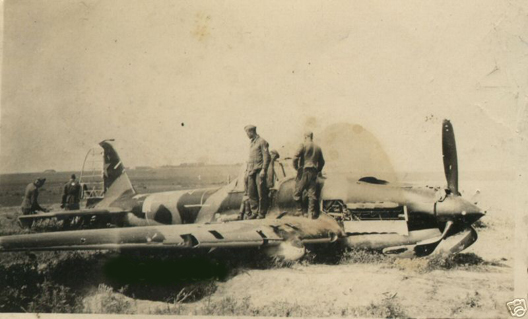
This striking Il-2 single-seat aircraft is the subject of another German
photograph, this presumably showing the photographer and his companions
in a souvenir hunting exercise. The camouflage on this example has been
discussed greatly, primarily for the fact that such a pattern is not known
in the photographic record to have been applied at any Il-2 factory.
However, that observation notwithstanding (and seemingly correct), I
am still of the opinion that this is indeed Soviet applied camouflage.
One feels certain that the colouration, despite being confronted with mysterious
German film, has got to be AII Green/Black/Blue. The patternation is absolutely
classic VVS; indeed, the aft fuselage pattern could have been taken directly
from virtually any La-5. It seems to me highly unlikely that any would-be
German 'artist' could replicate such an application so exactly, and moreover
in the correct types of colours. Whatever the origin of this scheme (i.e.
factory or field), I believe that it is not the result of this kind of
German 'doodle' work.
That MiG
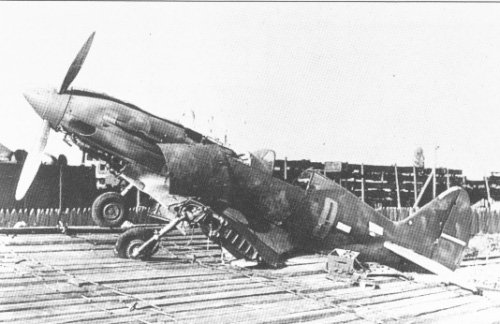
One presumes that no introduction is required for this photograph,
being one of the most recognizable Soviet aircraft images of the War. This
derelict MiG-3 is shown in a series of photos at a rail yard, presumably
being readied for transport, complete with descriptive manifests, labels,
and securing items. Obviously, the aircraft was retrieved from elsewhere
and brought to this location for this purpose. And therein, once again,
lies our curiosity about this example-- did this specimen receive more
'doodle' treatment whilst it sat out wherever it was before recovery?
The camouflage on this aircraft is again a case of applique. The base
colouration is in all probability AII Green, and over this has been applied
a second, unknown, colour. The pattern is unique, but in many ways it reminds
strongly of the other examples in this article which are thought to have
been completed by Germans, while at the same time the appearance matches
no other Soviet MiG examples, nor any other VVS camouflage technique. Further,
it is possible that some of the colour which was applied to the spinner
is still present at the root of the propeller blade. This is not at all
what one would expect had the aircraft been finished by the Soviets while
still in use.
. . . . . .
Alas, as with all of these examples, the factual truth of the matter
is simply unknown, and probably will never be provable. We are left with
supposition, logic, and so on to arrive at what can be, at best, a
most plausible solution. Unless-- quite literally-- some old German
pops up to say, "oh, yes, I did paint that, by the way...", that is best
we shall be able to do. On the other hand, the sheer number and similarity
of these examples hints strongly at some kind of commonality, and thus
a common solution.
It is upon that theme that we will labour at even greater length in
Part II....







